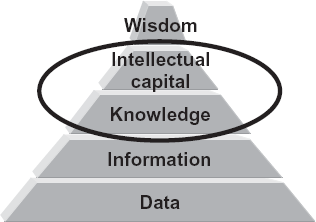Appendix A. Defining Key Terms
As we stated in the Preface, this book is primarily about knowledge and intellectual capital, and we have used the terms freely without asserting exact definitions. While expecting that many readers already have a good idea of the basic definitions of these terms, we want to give a bit more context so you can comprehend the terms as you read through the chapters.
Levels of Knowledge
Knowledge is composed of several components that lie on a continuum, shown in Figure A.1. Each level is defined in the following paragraphs, in order to show you how the definitions specifically apply to knowledge management.
Data and Information
Data is the raw material of knowledge management. It is at the base of the entire process. When you process this raw material—and today it is possible to process it using various technological systems—it becomes information. Information is processed data. But the information you end up with still does not address whatever managerial problems you face.

Figure A.1. FIGURE A.1 Levels of Knowledge
To illustrate, think of data and information in this metaphor, regarding solving a medical problem of a patient:
Get The Complete Guide to Knowledge Management: A Strategic Plan to Leverage Your Company's Intellectual Capital now with the O’Reilly learning platform.
O’Reilly members experience books, live events, courses curated by job role, and more from O’Reilly and nearly 200 top publishers.

